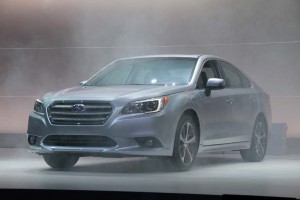When it comes to the road less traveled, Subaru has usually gone its own way, a strategy that has long paid off for the little Japanese maker – and the only manufacturer to continuously grow its sales in the U.S. during even the depths of the industry’s worst recession in decades.
Now, with the launch of an all-new Legacy topping off an unprecedented product blitz, Subaru is hoping to do it again this year. But as it grows ever larger, some are asking whether the very nature of the company may change, creating new challenges for Subaru going forward.
“When the industry hit the recession, Subaru took off,” boasted Jeff Walters, the maker’s U.S. sales manager, during a weekend media drive of the new Legacy.
In 2009, in fact, when the rest of the industry’s sales were collapsing, Subaru hit a new peak of 217,000. But the record didn’t last long, jumping to 264,000 just a year later. By 2013, that was up to 425,000. And while the official target for this year is 460,000, Walters believes the company is on track to beat that by an extra 3% to 5%.
All-new models, such as the 2015 Subaru Legacy, Outback and WRX STI, as well as recently refreshed offerings like the 2014 Forester, have been giving momentum to the brand.
(For a closer look at the 2015 Subaru Legacy, Click Here.)
Subaru is particularly optimistic about the new midsize sedan which, it notes, will be larger, roomier, better equipped and more powerful, yet fuel-efficient – though the base price jumps from $21,090 to $22,490, while the top level Legacy 3.5R increases $700, to $30,390.
The maker expects to sell just 32,218 Legacy sedans this year, barely 1% of the huge U.S. midsize segment. But it is betting that could nudge 60,000 over the next several years as the all-new model gets into full production.
(New technologies, like the Subaru Eyesight, allow motorists to see in new ways. Click Here for more.)
But, in some ways, the anticipated growth of the new Legacy reveals some of the challenges the maker could face going forward.
Until now, Subaru of America has been a quirky niche player with very distinct regional and psychographic targets. With its distinctive all-wheel-drive system backed by a targeted marketing strategy, it has an extraordinarily loyal following in Snowbelt states like Vermont and Colorado, with a strong appeal to not only rugged outdoor fans but nurses and gays – the maker being one of the first to openly target those with non-traditional lifestyles.
“But their growth is creating new challenges,” cautioned analyst Dave Sullivan, of AutoPacific, Inc. “There are a lot of unknowns going forward.”
Sales chief Walters doesn’t disagree. And it says Subaru will have to make inroads, for one thing, in markets – particularly in the Sunbelt 00 where it traditionally hasn’t had much of a presence.
(Click Here for a look at Subaru’s unusual Viziv hybrid concept vehicle.)
Subaru is “at a major turning point,” Yasuyuki Yoshinaga, president of the maker’s parent Fuji Heavy Industries, said last autumn, though he sounded a note of caution for those who think the maker might shift its focus from niche products like the Forester crossover and WRX hot hatch to become a true mainstream manufacturer.
“We’re not a carmaker that can grow as big as Toyota,” Yoshinaga told reporters. “And even if we could, reaching that sort of scale would mean we’d stop being Subaru.”
That said, Subaru seems certain to expand its line-up. It recently launched both the Crosstrek and the BRZ, the latter a rear-drive-only sports car and the maker’s only non-AWD model – and insiders hint a replacement for the upscale Tribeca is a couple years away.
The Crosstrek is Subaru’s first hybrid model and Sullivan and other analysts anticipate an all-electric model may be announced within the year as Subaru’s volumes will soon require the brand to meet California’s tough new Zero-Emissions Vehicle, or ZEV, mandate.
Subaru faces another challenge if it hopes to keep growing: a lack of capacity. It will struggle to meet even this year’s targets, but it will soon free up some additional space at its plant in Lafayette, Indiana when Toyota ends a joint venture there, transferring production of its segment-leading Camry sedan to one of its own U.S. plants. Subaru will follow by shifting production of the popular Forester from Japan to Indiana.
Long relegated to a regional niche player, Subaru is hoping to break more into the mainstream, and that could give it a boost. There are still plenty of challenges, Subaru officials admit, but if its performance over the last five years is any indication, it’s building the momentum it need.


The BRZ is rear-drive only.
Thanks for the catch, Adrian…we know better. Just a racing-for-deadline typo…now corrected.
Paul E.